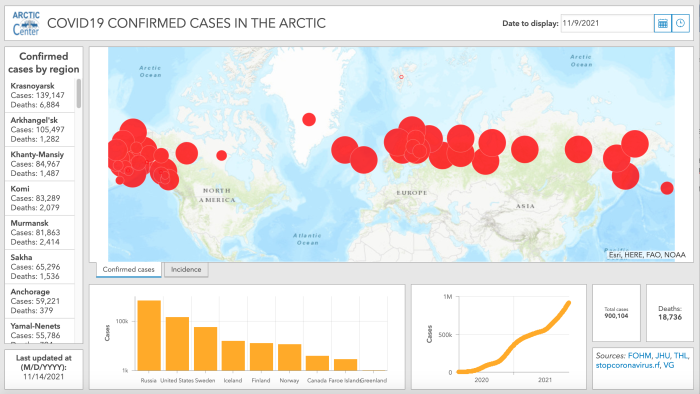By Andrey N. Petrov, ARCTICenter, University of Northern Iowa
Since the beginning of the pandemic and as of 9 November 2021, 896,232 Arctic residents were infected with COVID-19 and 18,628 died.
The Tracking the Spatiotemporal Dynamics of the COVID-19 Pandemic in the Arctic Project (COVITA) is funded by the National Science Foundation Arctic Social Sciences Program. (See: NSF RAPID Award Abstract # 2034886) The project, also known as Arctic COVID-19 has developed and deployed a real-time web-based COVID-19 data hub managed by an interdisciplinary team of experts in data science, geoinformatics, epidemiology, and geography. The team is collecting, analyzing, and disseminating data on the spatial and temporal dynamics of the COVID-19 infections and deaths in the Arctic from day-one of the pandemic, as well as vaccination in Arctic regions. Both unique datasets and analyses of spatiotemporal trends at the subregional level are made available to stakeholders, including Arctic residents, researchers, and policy makers (arcticcovid.uni.edu, Petrov et al., 2020, 2021a). Pandemic data are contextualized through the collection of first-person accounts of the COVID-19 experience in Arctic communities. The team is also developing geovisualization tools and analyzing datasets to address urgent questions related to the spread and geography of COVID-19 in the Arctic, assessing containment and mitigation policies and evaluating whether case fatality rates are affected by environmental, socioeconomic, and/or geographic variables. Long-term curation of Arctic COVID-19 data and data products will ensure availability for future analysis, historical study, and policy consideration.
The research team builds on their expertise in collection and analysis of diverse, multilingual datasets relevant to the incidence and spread of COVID-19 in the Arctic. Georeferenced quantitative data from North America, Scandinavia, and Russia are being collected from publicly available databases; variables will include basic demographic data, and rates of testing, morbidity, and mortality. Qualitative data on pandemic response, quarantine measures, mitigation efforts, and official announcements are being geotagged and catalogued for theme- and location-based searches. Multilingual narrative accounts of the experience of COVID-19 in Arctic communities will be collected virtually and, with informed consent, made available on the project's data hub.
In a recently published Nature Medicine article (Petrov et al., 2021b), the COVITA researchers examined COVID-19's impact on Indigenous populations in the Arctic and how it could be crucial to addressing the pandemic both today and in future epidemics. The study identified how the unique factors of the Arctic both aided and hindered the region's response to the first two major waves of the pandemic, which in many cases was more successful than in less remote areas in the same countries. However, regions that relaxed restrictions prematurely while remaining largely unprepared to tackle a possible surge and low vaccination rates (such as parts of Alaska and northern Russia) experienced a dramatic COVID-19 wave in the fall 2021.
The study finds that lessons learned in the Arctic may provide important resiliency tools against the spread of COVID-19 among vulnerable populations in other parts of the world, particularly in remote or Indigenous communities. We also conclude that places in which Indigenous knowledge and traditions were combined with effective public-health interventions may have had an advantage in fighting the pandemic.
Community testimonies demonstrate that although many Indigenous Arctic residents suffered from COVID-19, traditional subsistence practices and Indigenous knowledge provided strong emotional, mental, spiritual, and physical support throughout the pandemic. Places of traditional subsistence, such as tundra, rivers, lakes, and forests became zones of safety where Indigenous people were able to continue living without worries about getting infected, as well as avoiding hunger due to the store closures in the settlements.
In terms of cultural sustainability, the disproportionate impact of COVID-19 on elders, who have a special role in Indigenous societies, may also lead to the loss of tradition and language. At the same time, Indigenous Arctic residents possess unique sources of resilience embedded in Indigenous knowledge, according to the study. Generations-long disease-fighting experience and memory of previous pandemics, such as the 1918 influenza pandemic, have become relevant today, when bridging Indigenous and western scientific knowledge is viewed as a source of solutions for the COVID-19 crisis.
The study also found the remoteness of the region, coupled with strong isolation measures, allowed some communities with high socioeconomic and health vulnerabilities to weather the early stages of the pandemic and to be more prepared for the arrival of COVID-19. At the early stages of the pandemic, the Indigenous communities were able to battle the pandemic effectively with robust public health policies, such as rapid vaccinations, strong mandates for masking, medical isolation of those testing positive, tracing of cases, and curfews affecting social gatherings. However, the wave of infections during the second half of 2020 and in fall of 2021 exposed the "curse" of remoteness, with an explosive growth of SARS-CoV-2 in places with weak or too-quickly-relaxed measures.
More information on COVID-19 in the Arctic can be found at the Arctic COVID-19 project website.
References
Petrov, A.N., Welford, M., Golosov, N., DeGroote, J., Degai, T., & Savelyev, A. 2020. Spatiotemporal dynamics of the COVID-19 pandemic in the arctic: early data and emerging trends. International Journal of Circumpolar Health, 79(1), 1835251.
Petrov, A.N., Welford, M., Golosov, N., DeGroote, J., Devlin, M., Degai, T., & Savelyev, A. 2021. Lessons on COVID-19 from Indigenous and remote communities of the Arctic. Nature Medicine, 27(9), 1491-1492.
Petrov, A.N., Welford, M., Golosov, N., DeGroote, J., Devlin, M., Degai, T., & Savelyev, A. 2021. The "second wave" of the COVID-19 pandemic in the Arctic: regional and temporal dynamics. International Journal of Circumpolar Health, 80(1), 1925446.
About the Author
 Andrey N. Petrov is ARCTICenter Director and Associate Professor of Geography at the University of Northern Iowa. Dr. Petrov is an economic and social geographer who specializes in Arctic economy, regional development and post-Soviet society, with an emphasis on the Indigenous Peoples and local communities in Russia and other circumpolar countries. His current research is focused on regions of the Arctic and concerns regional development, spatial organization, and restructuring of peripheral economies, human wellbeing, dynamics of social-ecological systems and sustainable development. He has published on issues pertaining to socio-economic change, development, and demographic dynamics of Indigenous and non-Indigenous populations, relationships between communities and extractive industry, sustainability science and sustainable development in the Arctic. Dr. Petrov is the President of the International Arctic Social Sciences Association (IASSA).
Andrey N. Petrov is ARCTICenter Director and Associate Professor of Geography at the University of Northern Iowa. Dr. Petrov is an economic and social geographer who specializes in Arctic economy, regional development and post-Soviet society, with an emphasis on the Indigenous Peoples and local communities in Russia and other circumpolar countries. His current research is focused on regions of the Arctic and concerns regional development, spatial organization, and restructuring of peripheral economies, human wellbeing, dynamics of social-ecological systems and sustainable development. He has published on issues pertaining to socio-economic change, development, and demographic dynamics of Indigenous and non-Indigenous populations, relationships between communities and extractive industry, sustainability science and sustainable development in the Arctic. Dr. Petrov is the President of the International Arctic Social Sciences Association (IASSA).

